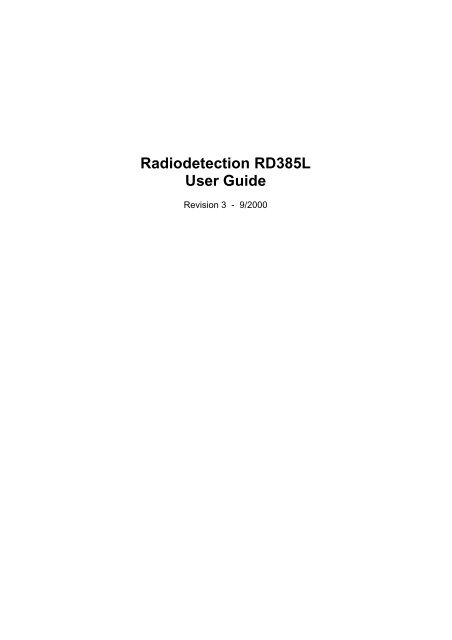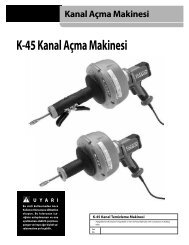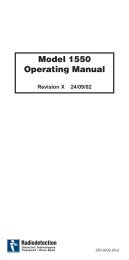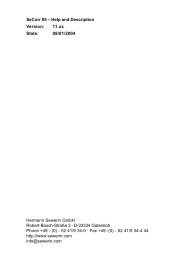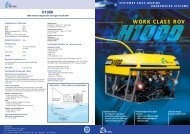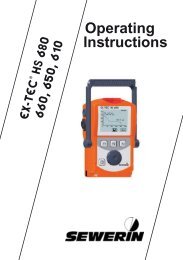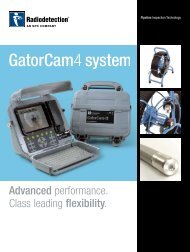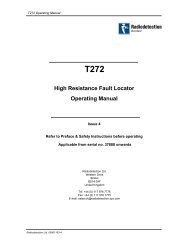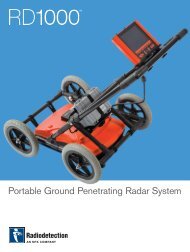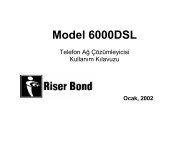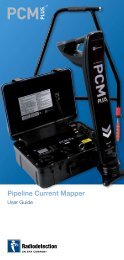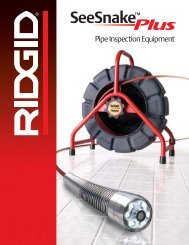Radiodetection RD385L User Guide
Radiodetection RD385L User Guide
Radiodetection RD385L User Guide
Create successful ePaper yourself
Turn your PDF publications into a flip-book with our unique Google optimized e-Paper software.
<strong>Radiodetection</strong> <strong>RD385L</strong><br />
<strong>User</strong> <strong>Guide</strong><br />
Revision 3 - 9/2000
<strong>Radiodetection</strong> <strong>RD385L</strong> <strong>User</strong> <strong>Guide</strong><br />
The <strong>RD385L</strong> System<br />
The <strong>RD385L</strong> System is designed to help in the<br />
operation of guided boring machines, and<br />
comprises:<br />
Touch gain<br />
Headphone<br />
socket<br />
Battery<br />
compartment<br />
Accessory<br />
panel<br />
Optional<br />
radio link<br />
<strong>RD385L</strong> Receiver<br />
A hand held receiver, which receives information<br />
from the Sonde relating to roll, tilt, depth, location,<br />
Sonde battery status and Sonde temperature. It<br />
can also be used as a cable/pipe locator.<br />
RD385 DataView (optional)<br />
A remote display which indicates roll, tilt and depth<br />
information from the <strong>RD385L</strong> Receiver. Located at<br />
the bore machine to provide information for<br />
steering.<br />
385L receiver.eps.art<br />
Depth<br />
Tilt<br />
Back light<br />
On/Off<br />
Alarm reset<br />
Power<br />
On/Off<br />
m<br />
12<br />
Poor reception<br />
9<br />
3 Sonde temp high<br />
P<br />
Sonde batt low<br />
P<br />
6<br />
DataView batt low<br />
Alarm status<br />
RD385 DataView<br />
<strong>Radiodetection</strong><br />
RD385 DataSonde<br />
The DataSonde is installed in the head of the bore<br />
tool, and contains the sensors that measure tilt, roll<br />
angle, temperature and battery life.<br />
Note: The RD385 Sonde has not been designed for<br />
use in percussive type bore machines.<br />
Bore heads may need to be modified to our<br />
specification to ensure adequate protection for the<br />
Sonde and to allow successful signal transfer from<br />
the Sonde to the <strong>RD385L</strong> Receiver.<br />
If in doubt, please request installation drawing from<br />
any <strong>Radiodetection</strong> office.<br />
RD380 Sonde; ND 1249.Q1.<br />
RD380 Sonde (in percussive environment); ND<br />
1249.Q5.<br />
RD385 Sonde: ND1327.Q1.<br />
RD385 Sonde (extra protection): ND1327.Q.
<strong>Radiodetection</strong> <strong>RD385L</strong> <strong>User</strong> <strong>Guide</strong><br />
Function Keys<br />
12<br />
9<br />
P<br />
6<br />
3<br />
8<br />
33<br />
On/Off (1)<br />
Press to turn Receiver On or Off. If no control key<br />
pressed, auto switch off after 5 mins preceded by<br />
audible warning.<br />
Batteries (2)<br />
Continuous indication of Receiver battery status.<br />
DataSonde battery status displayed when<br />
Temperature/Battery key pressed.<br />
1<br />
2<br />
9<br />
P<br />
12<br />
6<br />
3<br />
8<br />
33<br />
Self Test (3)<br />
To initiate a self test of the Receiver press and hold<br />
the Reset key and press the AGC key once. ‘tSt’ is<br />
displayed followed by either ‘PAS’ (Pass) or ‘FAL’<br />
(Fail).<br />
Reset (4)<br />
Press to cancel previously selected Depth, Current<br />
or Temperature/Battery functions.<br />
4 3<br />
12<br />
9<br />
3<br />
P<br />
6<br />
5 6<br />
8<br />
33<br />
Line/Sonde (5)<br />
Press to select Line, Sonde or Accessory mode,<br />
flag on LCD indicates which is selected.<br />
Mode (6)<br />
Press to select the following modes, flag on LCD<br />
indicates which is selected:<br />
50/60 Hz line locate mode.<br />
Radio frequency locate mode.<br />
8 8 kHz Transmitter/Sonde Frequency locate<br />
mode.<br />
33 33 kHz Transmitter/Sonde Frequency<br />
locate mode.<br />
Sonde DataSonde locate mode.<br />
9<br />
P<br />
12<br />
3<br />
8<br />
33<br />
Gain (7)<br />
Indicates Receiver gain level which is set by Touch<br />
Gain control unless Automatic Gain Control (AGC)<br />
is selected.<br />
6<br />
Bargraph (8)<br />
Indicates Receiver response to a signal.<br />
7<br />
8
<strong>Radiodetection</strong> <strong>RD385L</strong> <strong>User</strong> <strong>Guide</strong><br />
P<br />
9<br />
P<br />
12<br />
6<br />
3<br />
8<br />
33<br />
Tilt Angle (9)<br />
Continuously displayed in DataSonde mode.<br />
Roll Angle (10)<br />
Continuously displayed in DataSonde mode. When<br />
at display segment marked ‘P’ a Sonde Park<br />
initiates, saving 65% battery consumption.<br />
9<br />
10<br />
12<br />
Temperature/Battery (11)<br />
Press to display DataSonde temperature and<br />
battery status.<br />
C<br />
9<br />
P<br />
6<br />
3<br />
8<br />
33<br />
Speaker (12)<br />
Press to increase or decrease audio volume.<br />
12 11<br />
12<br />
Depth (13)<br />
Press to display estimated depth to Line/Sonde.<br />
Current (14)<br />
Press to display target line signal current (mA).<br />
P<br />
9<br />
P<br />
6<br />
3<br />
8<br />
33<br />
Sonde Depth Calibration<br />
This procedure must be performed before each<br />
bore.<br />
13 14<br />
Fit the Sonde into the bore head and lay on the<br />
ground in an area free of metallic objects or<br />
structures.<br />
Position the Receiver 1.5 - 2.5 m (5 - 8 ft) from the<br />
bore head.<br />
Select the DataSonde mode.<br />
Press the Reset and Depth keys together. LCD<br />
displays ‘cAL’.<br />
1.5m
<strong>Radiodetection</strong> <strong>RD385L</strong> <strong>User</strong> <strong>Guide</strong><br />
m<br />
9<br />
P<br />
12<br />
3<br />
8<br />
33<br />
Press the Depth key to calibrate. The Receiver will<br />
display the calculated depth, beep twice and return<br />
to the DataSonde mode.<br />
6<br />
To exit the calibration mode press the Reset key.<br />
The previous calibration will be retained.<br />
9<br />
P<br />
12<br />
6<br />
3<br />
8<br />
33<br />
If during calibration the LCD displays ‘rpt’, repeat<br />
the calibration procedure checking that the<br />
Receiver to bore head distance is within 1.5 - 2.5<br />
m (5 - 8 ft) parameter.<br />
12<br />
Pinpointing the Sonde<br />
9<br />
P<br />
6<br />
3<br />
8<br />
33<br />
Select the DataSonde mode.<br />
When the Receiver pinpoints the Sonde the<br />
bargraph and digital display indicate the maximum<br />
signal response.<br />
To keep the bargraph on scale adjust the Touch<br />
Gain control. Clockwise increases gain -<br />
anticlockwise decreases gain.<br />
Start the bore and pinpoint the Sonde after<br />
approximately 1 m (3.3 ft).<br />
1m<br />
The bore must be stopped to pinpoint the Sonde.
<strong>Radiodetection</strong> <strong>RD385L</strong> <strong>User</strong> <strong>Guide</strong><br />
2<br />
1<br />
Move the Receiver from side to side to obtain a<br />
peak response (1).<br />
Move the Receiver forwards and backwards (2) to<br />
obtain a second peak response.<br />
Rotate the Receiver as if a pivot to obtain a third<br />
peak response.<br />
Repeat to be directly over and in line with the bore<br />
head.<br />
Mark the pinpointed position over the DataSonde.<br />
Pinpoint and mark at regular intervals.<br />
Depth Measurement<br />
9<br />
P<br />
12<br />
3<br />
8<br />
33<br />
Stop the bore head and carry out the ‘Pinpointing<br />
the Sonde’ procedure. Rest the Receiver on the<br />
ground, holding it vertical and in line with the<br />
Sonde.<br />
6<br />
Press the Depth key, the LCD will display ‘dEP’<br />
followed by the estimated depth.<br />
Reading the Roll Angle<br />
9<br />
P<br />
12<br />
6<br />
3<br />
8<br />
33<br />
Roll Angle is continuously displayed in the<br />
DataSonde mode, by the 16 segment indicator<br />
when the bargraph shows over 20% signal<br />
strength. The bore head can be rotating to a<br />
maximum of 50 rpm.
<strong>Radiodetection</strong> <strong>RD385L</strong> <strong>User</strong> <strong>Guide</strong><br />
Reading the Tilt Angle<br />
12<br />
9<br />
P<br />
6<br />
3<br />
8<br />
33<br />
Tilt Angle is continuously displayed in the<br />
DataSonde mode, when the bargraph shows over<br />
20% signal strength. A more stable reading will be<br />
obtained if the bore head is stationary.<br />
Maximum Tilt Angles are:<br />
RD380 Sonde - 25°<br />
RD385 Sonde - 45°<br />
If using RD380 Sonde, Tilt Angle is only displayed<br />
when Roll Angle is at 12 o’clock.<br />
8<br />
33<br />
Temperature/Battery<br />
Press to display Sonde temperature and battery<br />
status. Sonde temperature should be read at each<br />
pinpoint.<br />
At 50°C (120°F) an alarm will be displayed.<br />
With every 5°C increase an alarm will be displayed<br />
(385 Sonde only).<br />
C<br />
8<br />
33<br />
C<br />
8<br />
33<br />
At 80°C (170°F) the bore must be halted to allow<br />
the sonde to cool or damage may occur. The<br />
Sonde stops transmitting Roll/Tilt information until it<br />
has cooled to 50°C.<br />
If the bore head is water cooled, continue water<br />
flow to assist cooling.
<strong>Radiodetection</strong> <strong>RD385L</strong> <strong>User</strong> <strong>Guide</strong><br />
12<br />
Parking the Sonde<br />
P<br />
9<br />
P<br />
3<br />
8<br />
33<br />
Leaving the Sonde in the Park position saves 65%<br />
battery consumption.<br />
Rotate the bore head until the ‘P’ segment is<br />
displayed. After 15 seconds a ‘P’ is displayed. After<br />
5 minutes the Sonde will switch off.<br />
Power Save Mode<br />
After 10 minutes of no rotation the Sonde will<br />
transmit a pulsed signal if not in the Park position.<br />
Rotating the bore head returns the Sonde to normal<br />
operation.<br />
Automatic Gain Control (AGC)<br />
12<br />
There may be long periods during bores when it is<br />
sufficient to know just Roll and Tilt information.<br />
9<br />
P<br />
6<br />
3<br />
8<br />
33<br />
During these periods the AGC option can be used.<br />
When in the AGC mode the Receiver will<br />
automatically adjust the sensitivity to keep the<br />
bargraph on scale and so ensure continuous Roll<br />
and Tilt information.<br />
Method:<br />
Pinpoint the DataSonde as previously described.<br />
Press the AGC key. The top left of the display will<br />
now show ‘AGC’ and the bargraph will show<br />
approximately 50%.<br />
The Receiver can be kept stationary until the bore<br />
passes out of range. Operating any control returns<br />
the Receiver to the normal mode.
<strong>Radiodetection</strong> <strong>RD385L</strong> <strong>User</strong> <strong>Guide</strong><br />
RD385 Slim Sonde<br />
The RD385 Slim Sonde is designed to be used for<br />
small diameter utilities installation (i.e. fibre optic<br />
links to domestic properties).<br />
Battery<br />
Insert the battery into the Slim Sonde observing the<br />
correct polarity - positive end in first.<br />
Note:Remove the battery when the Slim Sonde is<br />
not in use.<br />
Do not insert the battery reversed for storage<br />
(as with some sondes), this will cause it to be<br />
discharged.<br />
<strong>RD385L</strong> Mode Selection<br />
Press the Mode key to select the DataSonde mode.<br />
The pointers on the LCD will indicate DataSonde<br />
and 8 kHz.<br />
Press the Mode key again to select 33 kHz<br />
DataSonde mode which is the Slim Sonde<br />
operating frequency.<br />
9<br />
P<br />
9<br />
P<br />
12<br />
6<br />
12<br />
3<br />
3<br />
9<br />
P<br />
9<br />
P<br />
12<br />
6<br />
12<br />
3<br />
3<br />
9<br />
P<br />
9<br />
P<br />
12<br />
6<br />
12<br />
3<br />
3<br />
Roll Indication<br />
When operating in the 33 kHz DataSonde mode a<br />
single LCD segment is displayed at the 12, 3, 6 and<br />
9 o'clock points and two LCD segments at the 1, 2,<br />
4, 5, 7, 8, 10 and 11 o'clock points, as shown in the<br />
example.<br />
6<br />
6<br />
6<br />
Locate Modes<br />
The <strong>RD385L</strong> Receiver has a number of modes<br />
which allow it to be used as a standard cable/pipe<br />
locator.<br />
Recommended <strong>Radiodetection</strong> transmitter -<br />
RD400HPTx.
<strong>Radiodetection</strong> <strong>RD385L</strong> <strong>User</strong> <strong>Guide</strong><br />
DataView<br />
Check that the DataView batteries are good.<br />
Ensure that the Receiver and DataView have their<br />
antennas fitted.<br />
Position the DataView on the bore machine or on a<br />
tripod so that the display is clearly visible (ideally<br />
1.5 m above ground level, with the antenna<br />
vertical) by the machine operator.<br />
Switch the DataView On.<br />
Depth<br />
m<br />
12<br />
Poor reception<br />
Tilt<br />
9<br />
P<br />
P<br />
6<br />
3<br />
Sonde temp high<br />
Sonde batt low<br />
DataView batt low<br />
Alarm status<br />
Back light<br />
On/Off<br />
Alarm reset<br />
RD385 DataView<br />
Power<br />
On/Off<br />
Depth<br />
Tilt<br />
Back light<br />
On/Off<br />
Alarm reset<br />
Power<br />
On/Off<br />
m<br />
<strong>Radiodetection</strong><br />
12<br />
Poor reception<br />
9<br />
3 Sonde temp high<br />
P<br />
Sonde batt low<br />
P<br />
6<br />
DataView batt low<br />
Alarm status<br />
RD385 DataView<br />
<strong>Radiodetection</strong><br />
The DataView display will mimic the Receiver<br />
display while the data is being received with good<br />
signal strength.<br />
The DataView is fitted with a Backlight. Pressing<br />
the Backlight key on the DataView front panel<br />
illuminates the light. Operating the Backlight will<br />
effect the life of the batteries.<br />
The Backlight is only On while DataView is<br />
displaying data and switches Off when there is no<br />
data to display.<br />
The DataView display may flash, indicating an<br />
alarm condition is activated. Press the Reset key to<br />
cancel. The alarm condition will then be displayed.
<strong>Radiodetection</strong> <strong>RD385L</strong> <strong>User</strong> <strong>Guide</strong><br />
#11<br />
Error Codes<br />
Error #2<br />
Too much signal during self test, this can happen<br />
because there is another transmitter switched on<br />
during the test.<br />
Error #9<br />
Indicates that the signal is too small or too large to<br />
measure depth or current. If measuring depth to a<br />
target line check the Transmitter settings.<br />
Error #11<br />
Indicates that the Receiver is being moved while<br />
estimating depth.<br />
Error #12<br />
Indicates too much interference from external<br />
power sources to estimate depth.<br />
#21<br />
Error #13<br />
Indicates too much interference from external<br />
power sources to estimate current or depth.<br />
Error #20<br />
Indicates that current/depth to be measured is out<br />
of Receiver range.<br />
10m<br />
Error #21<br />
Indicates that the Sonde or target line is deeper<br />
than the maximum depth range, 10 m (33 ft) for<br />
Sonde or 3 m (10 ft) for target line.<br />
Warning<br />
The <strong>RD385L</strong> detects almost all buried cables<br />
and most conductors, but there are some which<br />
do not radiate signals and which the <strong>RD385L</strong><br />
cannot detect. The <strong>RD385L</strong> does not indicate<br />
whether a signal comes from a single cable or<br />
several buried side by side or one above<br />
another.
<strong>Radiodetection</strong> <strong>RD385L</strong> <strong>User</strong> <strong>Guide</strong><br />
Trouble Shooting<br />
When reporting any problem to your <strong>Radiodetection</strong><br />
Dealer/Supplier it is important to quote the following:<br />
Receiver Serial Number.<br />
Software Revision Number<br />
Software Revision Number is displayed on the LCD<br />
during switch on.<br />
Warning<br />
Do not remove or replace the radio antennae<br />
fitted to the Receiver and Dataview units, this<br />
invalidates the product radio licence and<br />
manufacturers warranty and may result in<br />
damage to the equipment.<br />
Replacement should only be undertaken by<br />
qualified <strong>Radiodetection</strong> service personel.<br />
Warning<br />
<strong>Radiodetection</strong> Receivers detect almost all<br />
buried cables and most conductors, but there<br />
are some which do not radiate signals and<br />
which <strong>Radiodetection</strong> Receivers cannot detect.<br />
<strong>Radiodetection</strong> Receivers do not indicate<br />
whether a signal is from a single cable, several<br />
buried side by side or one above another.<br />
This equipment is NOT approved for use in<br />
areas where hazardous gases may be present.<br />
Reduce audio level before using headphones.<br />
Ni-Cad batteries should be disposed of in<br />
accordance with your Company's work<br />
practice, and/or the relevant law or guidelines<br />
in your country.<br />
Warning<br />
The operation of any cable and pipe locator<br />
may be affected when used in close proximity<br />
to ferrous materials such as manhole covers<br />
and parked cars. Keep a one or two meter<br />
distance from these objects when taking critical<br />
measurements such as depth and current<br />
readings. Standing too close to the locator<br />
when wearing steel toe capped boots may also<br />
affect the readings.<br />
This instrument, or family of instruments, will not be<br />
permanently damaged by reasonable electrostatic<br />
discharge and has been tested in accordance with<br />
IEC 801-2. However, in extreme cases temporary<br />
malfunction may occur. If this happens, switch<br />
off, wait and switch on again. If the instrument still<br />
malfunctions, disconnect the batteries for a few<br />
seconds.
<strong>Radiodetection</strong> Ltd<br />
Western Drive<br />
Bristol BS14 0AF, UK<br />
Tel: +44 (0) 117 976 7776<br />
Fax: +44 (0) 117 976 7775<br />
email:sales.uk@radiodetection.spx.com<br />
http://www.radiodetection.com<br />
<strong>Radiodetection</strong> products are under continuous<br />
development and are subject to change without notice.<br />
Part No. 90/UG016EN03<br />
All rights reserved


